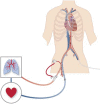Extracorporeal Membrane Oxygenation
- PMID: 35037618
- PMCID: PMC9342119
- DOI: 10.3238/arztebl.m2022.0068
Extracorporeal Membrane Oxygenation
Abstract
Background: Veno-venous extracorporeal membrane oxygenation (VV-ECMO) and veno-arterial extracorporeal membrane oxygenation (VA-ECMO), also known as extracorporeal life support (ECLS), can both be used to treat patients with acute pulmonary or cardiovascular failure.
Methods: This review is based on publications retrieved by a selective search in PubMed on the topics of cardiogenic shock and acute pulmonary failure, also known as the acute respiratory distress syndrome (ARDS), as well as on ECMO. Attention was given chiefly to randomized, controlled trials and guidelines.
Results: Initial findings from prospective, randomized trials of VV-ECMO are now available. Trials of ECLS therapy are now in progress or planned. A meta-analysis of two randomized, controlled trials of VV-ECMO for ARDS revealed more frequent survival 90 days after randomization among patients treated with VV-ECMO, compared to the control groups (36% vs. 48%; RR = 0.75 [95% confidence interval 0.6; 0.94]). For selected patients, after evaluation of the benefit-risk profile, VV-ECMO is a good treatment method for severe pulmonary failure, and ECLS for cardiogenic shock and resuscitation. The goal is to secure the circulation so that native heart function can be stabilized in the patient's further course or a permanent left-heart support system can be implanted, or else to support lung function until recovery.
Conclusion: ECMO is a valid option in selected patients when conservative treatment has failed.
Figures





Comment in
-
Implantation Strategies and ECMO Interhospital Transports.Dtsch Arztebl Int. 2022 Oct 7;119(40):685. doi: 10.3238/arztebl.m2022.0236. Dtsch Arztebl Int. 2022. PMID: 36594342 Free PMC article. No abstract available.
-
In Reply.Dtsch Arztebl Int. 2022 Oct 7;119(40):685-686. doi: 10.3238/arztebl.m2022.0237. Dtsch Arztebl Int. 2022. PMID: 36594343 Free PMC article. No abstract available.
References
-
- Peek GJ, Mugford M, Tiruvoipati R, et al. Efficacy and economic assessment of conventional ventilatory support versus extracorporeal membrane oxygenation for severe adult respiratory failure (CESAR): a multicentre randomised controlled trial. Lancet. 2009;374:1351–1363. - PubMed
-
- Combes A, Hajage D, Capellier G, et al. Extracorporeal membrane oxygenation for severe acute respiratory distress syndrome. Engl J Med. 2018;378:1965–1975. - PubMed
-
- Goligher EC, Tomlinson G, Hajage D, et al. Extracorporeal membrane oxygenation for severe acute respiratory distress syndrome and posterior probability of mortality benefit in a post hoc bayesian analysis of a randomized clinical trial. JAMA. 2018;320:2251–2259. - PubMed
Publication types
MeSH terms
LinkOut - more resources
Full Text Sources
Medical

